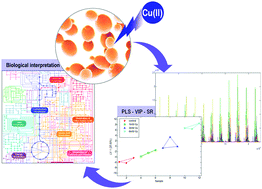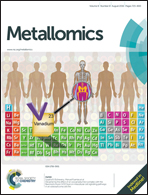LC-MS based metabolomics and chemometrics study of the toxic effects of copper on Saccharomyces cerevisiae
Abstract
Copper containing fungicides are used to protect vineyards from fungal infections. Higher residues of copper in grapes at toxic concentrations are potentially toxic and affect the microorganisms living in vineyards, such as Saccharomyces cerevisiae. In this study, the response of the metabolic profiles of S. cerevisiae at different concentrations of copper sulphate (control, 1 mM, 3 mM and 6 mM) was analysed by liquid chromatography coupled to mass spectrometry (LC-MS) and multivariate curve resolution-alternating least squares (MCR-ALS) using an untargeted metabolomics approach. Peak areas of the MCR-ALS resolved elution profiles in control and in Cu(II)-treated samples were compared using partial least squares regression (PLSR) and PLS-discriminant analysis (PLS-DA), and the intracellular metabolites best contributing to sample discrimination were selected and identified. Fourteen metabolites showed significant concentration changes upon Cu(II) exposure, following a dose–response effect. The observed changes were consistent with the expected effects of Cu(II) toxicity, including oxidative stress and DNA damage. This research confirmed that LC-MS based metabolomics coupled to chemometric methods are a powerful approach for discerning metabolomics changes in S. cerevisiae and for elucidating modes of toxicity of environmental stressors, including heavy metals like Cu(II).


 Please wait while we load your content...
Please wait while we load your content...